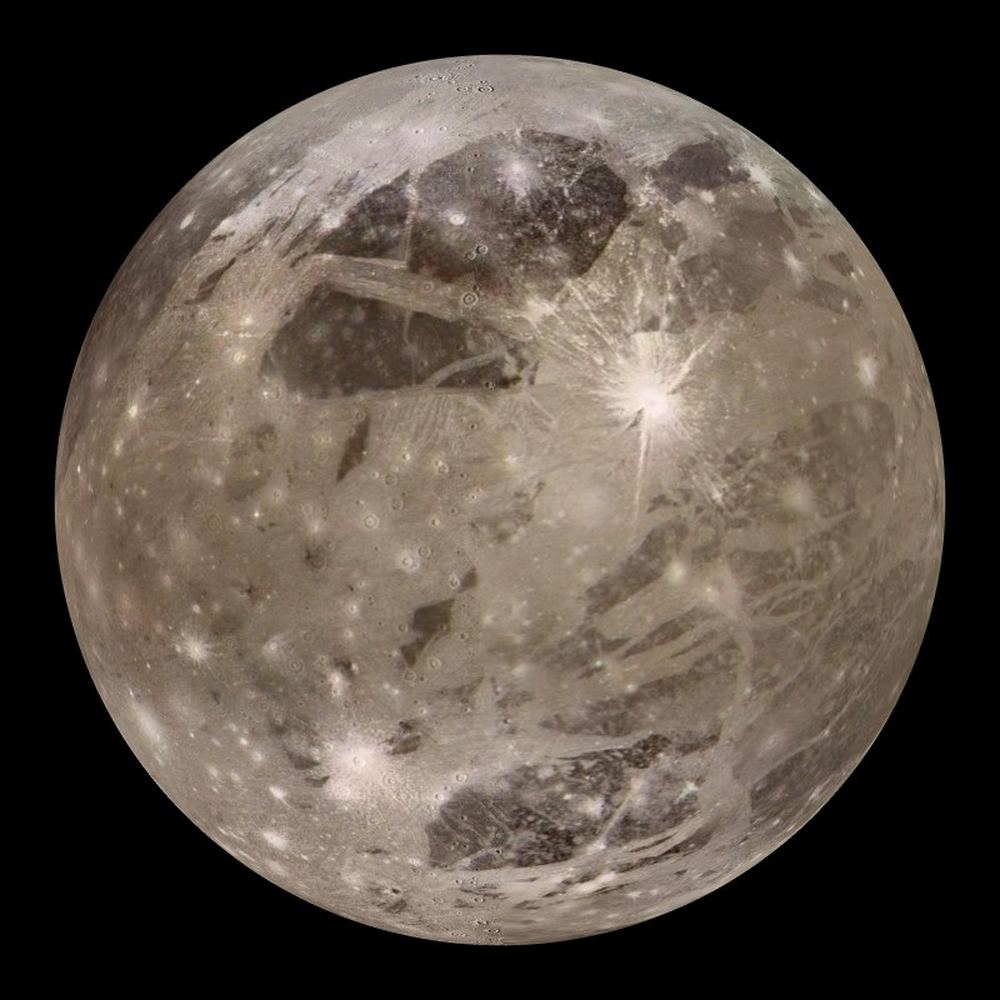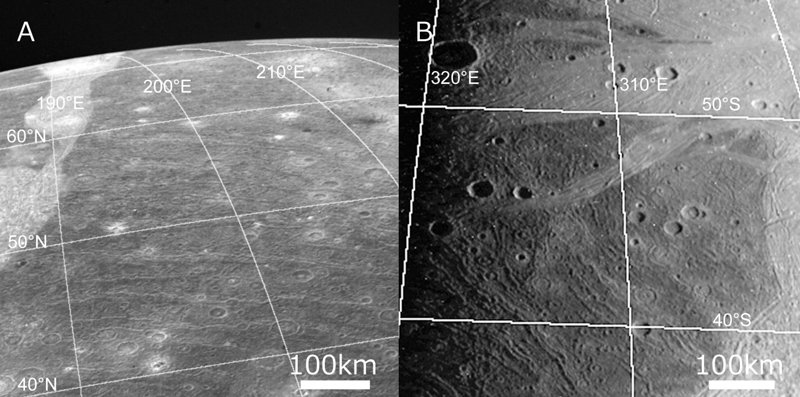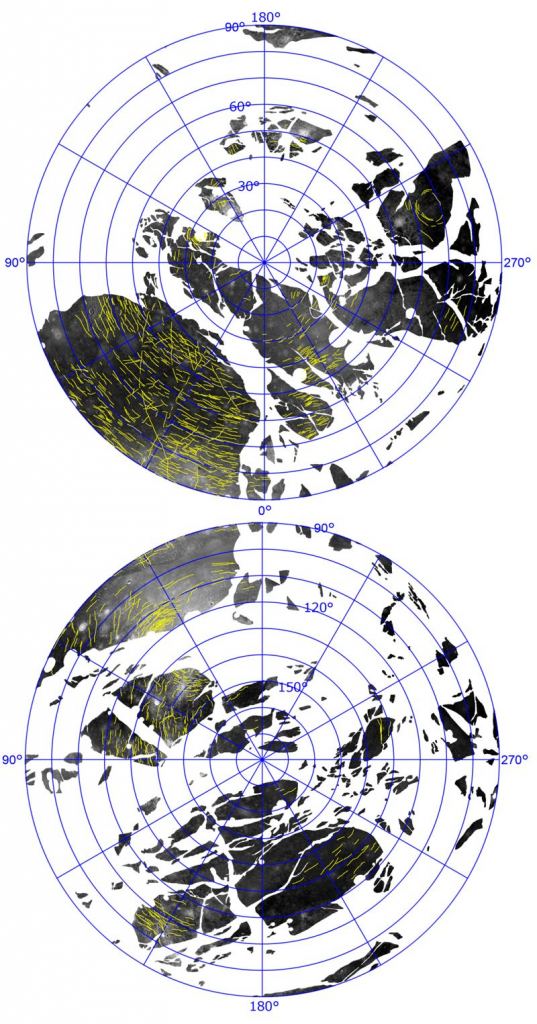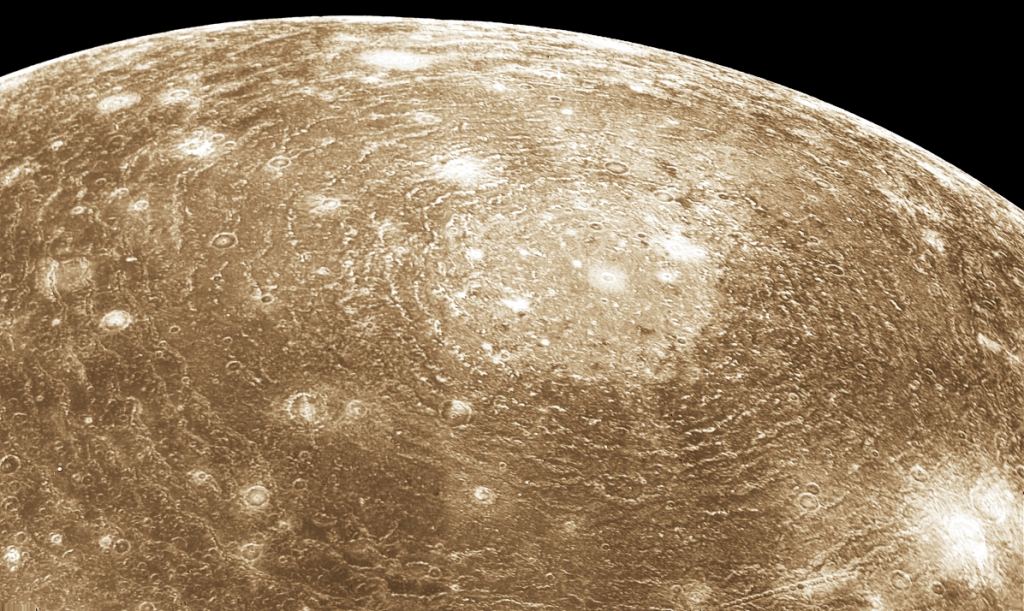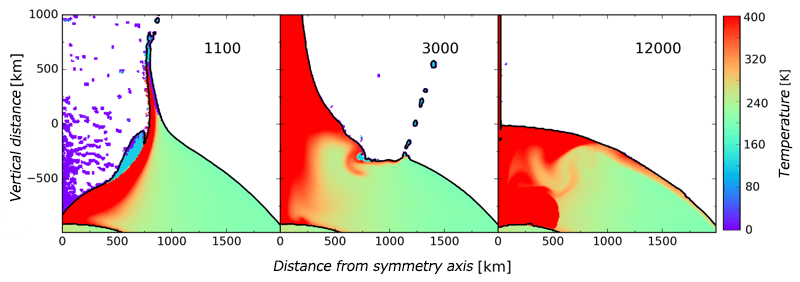Ganymede's surface is a bit of a puzzle for planetary scientists. About two-thirds of its surface is covered in lighter terrain, while the remainder is darker. Both types of terrain are ancient, with the lighter portion being slightly younger. The two types of terrain are spread around the moon, and the darker terrain contains concurrent furrows.
For the most part, scientists think that the furrows were caused by tectonic activity, possibly related to tidal heating as the moon went through unstable orbital resonances in the past.
But a new study says that a massive impact might be responsible for all those furrows.
Ganymede's surface is mostly ice, not rock. It's a differentitated body with a rocky core and a subsurface ocean that may contain more water than all of Earth's oceans combined. Our detailed image data of Jupiter's—and the Solar System's—largest moon is largely from the Voyager missions and the Galileo mission. The new study re-examined all that data "in order to investigate the orientation and distribution of the ancient tectonic troughs" as a press release says.
The title of the study is " A global system of furrows on Ganymede indicative of their creation in a single impact event." Lead author is Naoyuki Hirata of Kobe University, Japan. The study is published in the journal Icarus.
Jupiter, Ganymede, and the other Galilean moons are objects of great interest to scientists. How that system of planet and moons formed and evolved is connected to how the rest of our Solar System evolved. Three of the Jovian moons, including Ganymede, have subsurface oceans, and are targets of interest in the search for life.
NASA's Juno mission is at Jupiter right now, and other missions are in the planning stages. The ESA's JUICE (Jupiter Icy Moon Explorer) mission will launch in 2022, and NASA's Europa Clipper mission is scheduled for launch in 2024.
This study is partly aimed at those future missions. Not only did the team of researchers want to focus on one aspect of Ganymede, they wanted to contribute towards these future missions. They focused on the ridged, furrowed terrain that dominates the moon. They hope that by focusing on these geological formations, they could begin to reconstruct Ganymede's past. Work like theirs should provide some focus and context for the future missions.
The dark terrain is the oldest terrain on Ganymede, and so its troughs are likely the moon's oldest geological feature. The troughs are also layered with craters, which helps make the case for them being the most ancient features.
This new study analyzes the troughs and how they're distributed over Ganymede's surface. The team found that the troughs are all aligned concentrically around a single point. When looking at the entire surface of the moon, the features form giant concentric rings around the globe.
The team thinks the concentric rings are actually one enormous, moon-wide impact crater. There are only minimal deviations in the pattern, indicating that the dark blocks of terrain on Ganymede's surface haven't changed much in a long time. Since the crater was formed prior to the younger, brighter terrain, it shows that the dark blocks remain relatively unchanged, even during the later formation of the lighter terrain.
Their analysis shows that the rings were formed when an asteroid with a 150 km (93 mi) radius collided with Ganymede, travelling at a speed of 20 km/s (12.5 mph).
Callisto, another of Jupiter's moons, also has an enormous ring structure named the Valhalla Crater. Valhalla Crater has an approximate radius of 1900 km (1180 mi), making it the largest multi-ring crater in the Solar System. But if the results of this study stand, then Valhalla will be demoted. The Ganymede multi-ring crater has a radius of approximately 7800 km (4850 mi.)
At the heart of the team's work is a computer simulation. They used a computer cluster at the National Astronomical Observatory of Japan (NAOJ) to determine the size of the impactor, and its speed. They also determined that the collision took place about 4 billion years ago.
https://gfycat.com/distantnearfishingcat
One of the big questions related to this discovery concerns Ganymede's interior structure, and its evolution.
In some ways, Ganymede's sister moon is Callisto, since they're roughly the same size, and both likely have subsurface oceans. But researchers think that Callisto doesn't have a differentiated interior structure. On the other hand, Ganymede has layers of ice, water, and rock. Those differentiated layers require an enormous amount of heat to form, and that heat could've been created by the large impact. Callisto also has an impact crater, though much smaller than Ganymede's, so it's possible that the impact didn't generate enough heat to created a differentiated interior structure.
One of the difficulties in studying Ganymede is that even though both Voyager spacecraft and the Galileo spacecraft visited the moon, the surface is not completely imaged. Future missions should rectify that, hopefully with higher definition images and other up-to-date data based on newer technology. Not only can they study the massive multi-ring crater in much more detail, they can survey the surface for evidence of other large-scale events. These missions should be able to test the team's results, and hopefully prove or disprove them.
The end result of this study, and of future missions to the region, should be a better understanding of how Ganymede and other moons in the Jupiter system formed and evolved.
More:
- Press Release: Huge ring-like structure on the surface of Jupiter’s moon Ganymede may have been caused by a violent impact
- Published Research: A global system of furrows on Ganymede indicative of their creation in a single impact event
- Universe Today: Even Ganymede is Showing Tectonic Activity. We’re Going to Need Another Icy Moon Orbiter
 Universe Today
Universe Today
